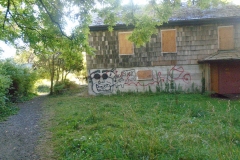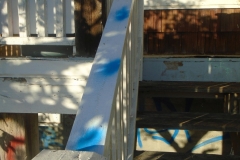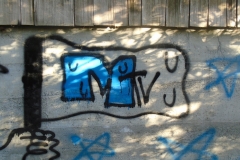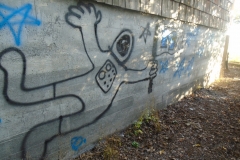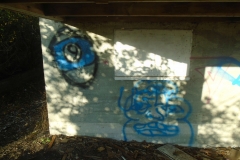
by George Le Masurier | Oct 16, 2017
The purposeful neglect of the Mack Laing heritage house by the Town of Comox has reached a new low.
Hamilton Mack Laing gave his house, known as Shakesides, along with a substantial sum of money in his Last Will and Testament for the purpose of converting it into a public natural history museum. Laing, an internationally respected naturalist and ornithologist, died in 1982.
But the town has done nothing over the intervening 35 years to comply with Laing’s last wishes, and has intentionally let the building fall into disrepair. Council members apparently hope their neglect will garner support for the effort to tear it down.
But the Mack Laing Heritage Society (MLHS) hopes to preserve Shakesides in its current condition, at least until the B.C. Supreme Court rules on the town’s application to demolish the building. That seems reasonable.
And it was in that spirit that MLHS offered to place a tarp on the roof of Shakesides to prevent moisture from entering the building through a decades-old roof and to stop further deterioration of the famous naturalist’s home on Comox Bay.With another wet winter in the forecast, council members should have accepted the offer. Especially because MLHS members proposed to pay the entire labor cost of a professional installation.
And they made this offer with plenty of time to get such a simple task done over last spring and summer.

Vandals recently attacked Shakesides for the second time, but no other structure in Mack Laing Park. That suggests the vandalism is politically motivated. See the full gallery of photographs below.
MLHS President J-Kris Nielsen first presented the group’s offer verbally at a Committee of the Whole meeting on March 22, 2017, complete with projected costs. He followed that up with an April 17 letter to the town detailing a work plan that included drawings and itemized material costs totalling $1,892.80.
The letter was officially stamped “Received” on April 20, 2017.
Seven months later, the town has yet to respond. Not a letter. Not an email. Not a phone call.
The Town of Comox voted unanimously in February to ask the B.C. Supreme Court to release the town from the terms of the trust established by Laing’s Last Will. That would allow them to demolish the house. No court date has been set.
So the council might have figured, why spend even $1,800 to preserve a building we hope to tear down? Fair enough, but doesn’t decency require a reply to well-intentioned citizens, at the least?
And consider this:
The town has hired the law firm Young & Anderson to make their case for demolition to the province’s high court. If they succeed, the town has committed to spend around $300,000 of taxpayer’s money to pay lawyers, demolish the building and build a viewing platform.
Yet council members can’t find $1,800 for a group of passionate citizens to tarp the roof? The MLHS might have even paid the whole bill if council had made a civil response.
It’s shameful. But no surprise.
For 35 years, the Town of Comox has neglected the last wishes of this important literary and ornithological person, and mismanaged his trusts. It’s shameful how the town has claimed Laing’s celebrity, when convenient, but has always ignored his desire for a legacy.
Those who prefer to save Shakesides have criticized council and pressured them to act. But that’s no justification for a town government to disrespect its citizens. Or act vindictively. They deserved a reply.
And, really, it seems only fair to put a tarp on a leaking roof until the Supreme Court hears the case, because there’s no guarantee how the court will rule, or view the town’s behavior in this matter.
Meanwhile, Shakesides recently suffered another attack by pretend graffiti artists.
Like the graffiti attack in April, vandals again spray-painted the historical home with lame images. It wasn’t serious tagging, much less artwork.
These latest vandals might be the same person or group of people. They just made a better effort. We’ll never know for sure.
But it is interesting that, like the last attack, no other sign, bridge, post or tree was spray-painted. That makes it likely that this defacing of public property is somehow connected to the political and legal battle over the preservation of Laing’s home.
And, of course, the defacing fits nicely with the Town Council’s policy of intentional neglect.

by George Le Masurier | Mar 31, 2017
Comox Councillor Barbara Price has offered up misleading statements to defend changes to an antiquated sewerage system that serves only Comox and Courtenay residents.
Price chairs the Comox Valley Sewage Commission, which is itself a misnomer. The Sewage Commission does not serve or represent the Comox Valley. It represents the sole interests of the Town of Comox, the City of Courtenay and CFB Comox.
A nearly equal amount of the Comox Valley’s population resides outside these two municipalities and relies on septic systems and wells for their water and sewage treatment. The Village of Cumberland manages its own wastewater.
So Price stretches the truth when she writes that the Comox Valley Regional District is “… planning and managing sewage operations for the region.” That’s a true statement only if you narrowly define ‘region’ as Courtenay and Comox. But Price attempts to give the impression of a broader interest.
The irony of Price’s fake fact is that a Valley-wide sewerage system is exactly what the CVRD should be doing. Instead of furthering the patchwork delivery of wastewater services, which creates inter-jurisdictional fights, the Comox Valley should have a 21st Century model for comprehensive and fair delivery of wastewater collection and treatment.
The issue of the moment is the Courtenay-Comox Sewage Commission’s plan to build a large pump station on Beech Street, which resides in Area B, not within the municipal boundaries of either the Town of Comox or the City of Courtenay.
On that point, Price also misleads readers when she suggests that the commission followed “proper processes” in selecting the Beech Street site, which she also calls the “preferred location.”
A proper process to site such an important public facility would have been transparent. As is required in the Town of Comox, several possible locations would have been identified and the public would have had input before the commission authorized purchase of any property. A fair process would have given a vote to the Area B director who represents people most directly affected by the facility.
But the sewage commission did all of this work in secret. By shutting out the public, and delaying announcement of the property purchase until after the 2014 municipal elections, the commission showed a callous disregard for public sentiment and open governance.
The Beech Street location was not the preferred location of the commission’s own Advisory Committee — formed after the property purchase was announced and comprising elected officials, staff and Beech Street neighbors. The committee gave its top recommendation to upgrading the existing pump station in Courtenay, and for good reason.
Two separate financial analyses — one by the regional district itself and another by a qualified citizen — showed that upgrading the Courtenay No. 1 pump station was less expensive. The independent report predicted savings of $7 million to $12 million in the long-term.
In her op-ed column Price writes that the Comox No. 2 pump station will only be built if it “can be built safely, without harm to neighbours and their necessities (such as well-water access.” CVRD Engineer Kris La Rose made a similar promise in a meeting with Beech Street neighbors last summer. He promised the new pump station would not create any odour or noise discernible beyond the facility’s property line.
Those are bold promises. But can the public have any faith in their veracity? The Courtenay/Comox Sewage Commission made similar promises to residents of the Willemar Bluffs about property erosion and to the Curtis/Brent road residents about odours.
Both sets of residents successfully sued the regional district because the commission’s promises were proved untrue. More than 30 years later, odours from the treatment plant still drift through the neighborhood, which remains skeptical of yet another plan in 2017 to fix the problem.
The Comox Valley faces a watershed moment. Elected officials can choose to invest in patchwork infrastructure that shackles us for decades to deteriorating and outdated technology, or they can create a 21st Century model: a Valley-wide shared service that addresses population growth, new technology and climate change and takes in more service areas and more ratepayers so the burden — and benefits — can be shared more widely.
If not now, then when?
Does the Comox Valley have visionary leaders who see the big picture and consider the long-term? Do we have leaders willing to debate the merits of building a world-class Valley-wide sewerage system with tertiary treatment and resource recovery?
Or, do we have leaders stuck in the past, afraid to think of the greater good because it would be a long, hard sell to voters?
Other North American cities already clean their wastewater to point of reinjecting it into groundwater supplies and, in some cases, directly back into public drinking water systems. They use the byproducts of treatment to fuel their plants, and provide suitable water for agriculture irrigation.
Why can’t the Comox Valley take such a forward-thinking approach?



